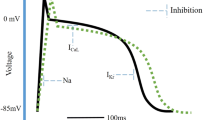Summary
BACKGROUND: The clinical course of patients with advanced organic heart disease is often complicated by the occurrence of atrial fibrillation. Slowing the ventricular rate and, if possible, restoration of normal sinus rhythm is crucial but difficult in the state of decreased ventricular function. METHODS: We included 78 consecutive patients with atrial fibrillation and heart rate above 135 beats min-1 in an observational, uncontrolled study in the coronary care unit of a tertiary care center. Thirty-nine patients suffered from advanced congestive heart failure, 26 patients had pulmonary edema, and 13 patients were in cardiogenic shock. All patients were treated with 450 mg of amiodarone given as a single intravenous bolus through a peripheral venous access without further infusion. Ventricular heart rate and cardiac rhythm were measured within 30 minutes after drug administration. Cardiac rhythm was monitored for 24 hours. The site of venous access was examined 30 minutes after drug administration and every 6 hours until the needle was removed after a maximum of 48 hours. RESULTS: Twenty-five patients (32%) converted to normal sinus rhythm within 30 minutes. Another 15 (19%) reverted into sinus rhythm during the following 24 hours. Within 30 minutes after amiodarone administration, ventricular heart rate decreased significantly from 152 ± 12 to 88 ± 17 (p < 0.0001) beats min–1 in patients who converted to sinus rhythm and from 157 ± 14 to 98 ± 16 beats min-1 in patients who did not. The degree of reduction in heart rate was similar among patients presenting with exacerbated congestive heart failure, pulmonary edema, or cardiogenic shock. Systolic blood pressure decreased in two patients, from 115 to 80 mm Hg and from 130 to 100 mm Hg, but was reversible after 10 and 90 minutes respectively without specific intervention. No proarrhythmia or clinical relevant bradycardia was observed, and no inflammation detected at the site of venous access. CONCLUSIONS: Amiodarone, given as a single intravenous bolus through a peripheral vein, rapidly reduced ventricular rate and was well tolerated in patients with atrial fibrillation, even in the presence of congestive heart failure and cardiogenic shock.
Similar content being viewed by others
Author information
Authors and Affiliations
Corresponding author
Rights and permissions
About this article
Cite this article
Hofmann, R., Steinwender, C., Kammler, J. et al. Intravenous amiodarone bolus for treatment of atrial fibrillation in patients with advanced congestive heart failure or cardiogenic shock. Wien Klin Wochenschr 116, 744–749 (2004). https://doi.org/10.1007/s00508-004-0264-0
Received:
Accepted:
Published:
Issue Date:
DOI: https://doi.org/10.1007/s00508-004-0264-0




